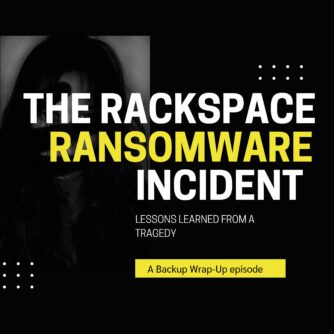In the era of cloud computing, disaster recovery has become a critical aspect of any organization’s IT strategy. As more businesses rely on cloud services to store and manage their data, it’s crucial to have a robust plan in place to ensure business continuity and data protection. In this blog post, we’ll explore the essential cloud disaster recovery best practices that every organization should implement.
This blog post summarizes the main points of my latest podcast episode. If you’d like, you can listen to it at https://www.backupwrapup.com/cloud-dr-lessons-from-real-world-failures.
In the episode, we dive deep into the strategies and techniques that can help you safeguard your valuable data in the cloud. An often ignored and basic strategy is that of the 3-2-1 rule. This rule states that you should have three copies of your data, stored on two different type of media, with one copy kept offsite. By adhering to this rule, you ensure that your data is protected even if one copy is lost or compromised. However, many organizations mistakenly believe that their cloud provider’s built-in backup features are sufficient. In reality, these features often have limitations and may not provide the level of protection and recoverability you need.
Another crucial aspect of cloud disaster recovery is regularly testing your plan. It’s not enough to have a plan in place; you need to ensure that it actually works when disaster strikes. Regular testing helps identify gaps in your strategy, allowing you to make necessary improvements and adjustments. It also familiarizes your team with the recovery process, reducing the chances of errors and delays during a real crisis.
When it comes to choosing a cloud provider, it’s essential to consider their disaster recovery capabilities. Not all providers are created equal, and some may have more robust and reliable DR solutions than others. Look for providers that offer geographically distributed data centers, automated failover, and comprehensive backup and recovery options. It’s also crucial to understand the shared responsibility model and clearly define the roles and responsibilities of both your organization and the cloud provider in the event of a disaster.
In addition to relying on your cloud provider’s DR capabilities, it’s highly recommended to use third-party backup solutions. These solutions provide an extra layer of protection and give you greater control over your data. They allow you to backup and recover your data independently of your cloud provider, ensuring that you have a reliable and accessible copy even if the provider experiences an outage or data loss.
Another important consideration in cloud disaster recovery is the recovery time objective (RTO) and recovery point objective (RPO) of your data. RTO refers to the maximum tolerable downtime before your business operations are severely impacted, while RPO represents the maximum acceptable data loss. Understanding these metrics helps you design a disaster recovery plan that aligns with your business requirements and minimizes the impact of disruptions.
It’s also crucial to regularly review and update your cloud disaster recovery plan. As your business evolves and technology advances, your DR strategy should adapt accordingly. Regularly assess your plan to identify areas for improvement, incorporate new best practices, and ensure that it continues to meet your organization’s changing needs.
In conclusion, protecting your data in the cloud requires a proactive and comprehensive approach to disaster recovery. By following best practices such as the 3-2-1 rule, regularly testing your plan, choosing a reliable cloud provider, and utilizing third-party backup solutions, you can significantly reduce the risk of data loss and ensure business continuity. Remember, the key to successful cloud disaster recovery is preparedness, diligence, and continuous improvement.
Written by W. Curtis Preston (@wcpreston), four-time O'Reilly author, and host of The Backup Wrap-up podcast. I am now the Technology Evangelist at Sullivan Strickler, which helps companies manage their legacy data






